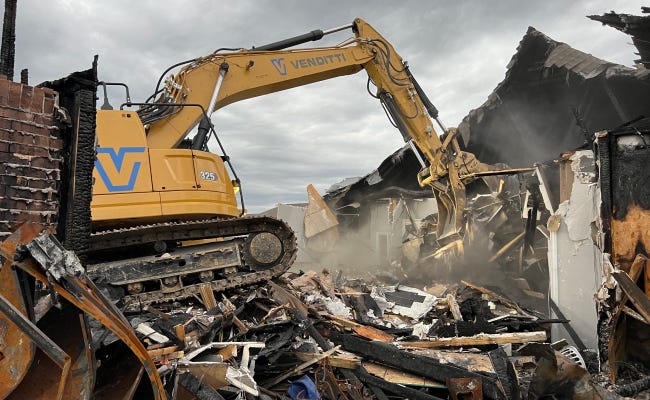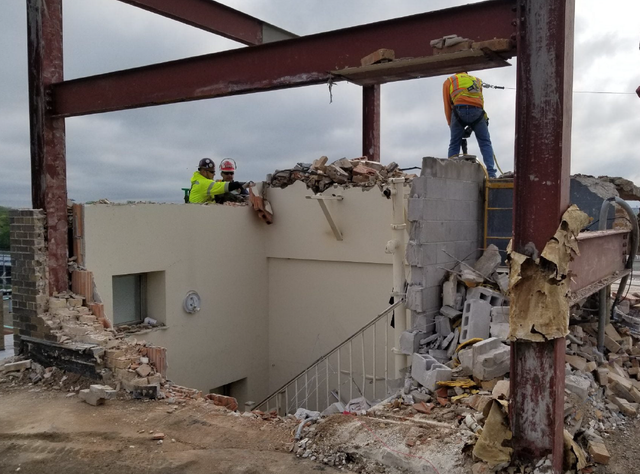Ecological Sustainability in Interior Demolition: Strategies for Accountable Practices
Ecological Sustainability in Interior Demolition: Strategies for Accountable Practices
Blog Article
The Ultimate Overview to Inside Demolition Techniques and Tools
Within the realm of indoor renovations, the art of demolition is an essential phase that calls for accuracy, ability, and the right collection of tools. Whether you are a seasoned specialist or a Do it yourself fanatic, recognizing the ins and outs of interior demolition methods can make all the difference in attaining an effective job result.
Vital Interior Demolition Devices
When taking on indoor demolition projects, having the ideal tools is important for performance and safety and security. One of one of the most important tools for indoor demolition is the demolition hammer. This durable tool is developed to appear difficult products like floor tile, concrete, and drywall. Its effective hammering action can quickly knock down walls, floorings, and other structures. In addition, a crowbar is crucial for eliminating fixtures, trim, and various other products. Its take advantage of permits the simple extraction of nails and various other fasteners without harming the surrounding surfaces - interior demolition.
One more important device is a reciprocating saw, which is excellent for cutting via a range of materials such as plastic, steel, and timber. Its ability to make exact cuts in limited spaces makes it perfect for demolition work. An utility knife is essential for cutting materials like rug, vinyl flooring, and insulation. Its sharp blade makes sure tidy and exact cuts, facilitating the removal of unwanted materials. Overall, having these essential interior demolition tools will substantially improve the performance and safety and security of any kind of demolition task.

Safety And Security Safety Measures During Demolition

In addition, all workers entailed in the demolition process ought to receive adequate training on the correct handling of devices and tools to minimize mishaps. By sticking to these safety and security precautions, indoor demolition jobs can be carried out successfully while prioritizing the well-being of all people involved.
Techniques for Getting Rid Of Walls
Implementing appropriate safety preventative measures during indoor demolition projects is vital for creating a safe and secure workplace, and one essential facet of such jobs involves understanding methods for removing wall surfaces. One commonly made use of technique is hand-operated demolition, which requires making use of fundamental hand devices such as sledgehammers, crowbars, and utility blades to very carefully dismantle the wall surface piece by item. This method permits greater control over the demolition process, especially in fragile locations where precision is important.
For bigger, more intricate walls, mechanical demolition might be required. This entails using hefty equipment like excavators or excavators to knock down wall surfaces successfully. Nonetheless, it is vital to guarantee that the architectural honesty of the building is not jeopardized during mechanical demolition.
One more technique for getting rid of walls is deconstruction, where the wall is taken apart in a manner that maintains multiple-use products. This sustainable address approach is eco friendly and can likewise help lower disposal costs. Whichever technique is employed, it is vital to follow proper safety methods and consider the architectural ramifications of wall surface removal to guarantee an effective interior demolition job.
Removing Floor Covering Like a Pro
Effectively getting rid of floor covering during interior demolition requires the correct devices and methods to make sure a smooth and successful procedure. The primary step in removing flooring is to get rid of the location of any type of furnishings or barriers. Next off, determine the kind of floor covering to determine the appropriate removal technique. For wood or laminate floor covering, beginning by eliminating the walls and after that make use of a floor covering scraper to lift and detach the planks. Carpet elimination entails reducing the carpet right into convenient sections and rolling it up for disposal. For tile or plastic flooring, a sculpt or floor scraper can be used to pry up the sheets or floor tiles. It's vital to use safety equipment such as gloves, goggles, and a mask to stop injuries and exposure to dirt and particles. Furthermore, having a dumpster or assigned disposal location ready for the eliminated floor covering materials is essential for preserving a tidy workplace. By complying with these strategies and utilizing the right devices, removing flooring like a pro can be attained efficiently and properly.
Proper Garbage Disposal Methods
After successfully removing flooring making use of the appropriate devices and techniques, the following essential action in the indoor demolition procedure is executing appropriate waste disposal methods. Proper garbage disposal is essential for maintaining a secure and tidy work environment during and after demolition. Among the key techniques for waste disposal is segregating materials right into various classifications such as recyclable, unsafe, and basic waste. This segregation guarantees that materials are thrown away properly and responsibly.

Service providers need to comply with neighborhood policies pertaining to garbage disposal to prevent fines and fines. Utilizing professional waste management services can simplify the disposal process and make click to read sure conformity with ecological guidelines. By applying proper waste disposal techniques, indoor demolition tasks can be finished effectively and sustainably.
Conclusion
In verdict, indoor demolition requires the usage of crucial tools and rigorous safety and security precautions to ensure a safe and successful procedure. By complying with these guidelines, interior demolition can be completed properly and with marginal risks.
One of the most important devices for interior demolition is the demolition hammer (interior demolition). In general, having these essential interior demolition tools will considerably enhance the performance and security of any type of demolition project
Efficiently eliminating flooring throughout interior demolition needs the proper why not try this out devices and methods to make sure a successful and smooth process.After efficiently getting rid of floor covering using the appropriate devices and techniques, the following vital action in the indoor demolition process is applying appropriate waste disposal approaches.In final thought, interior demolition needs the use of essential devices and strict safety preventative measures to guarantee a effective and secure procedure.
Report this page